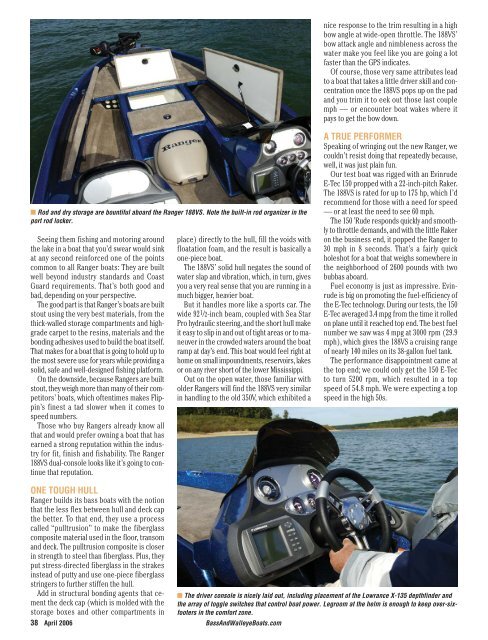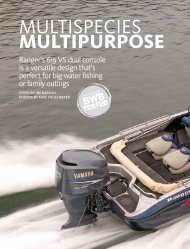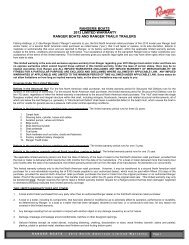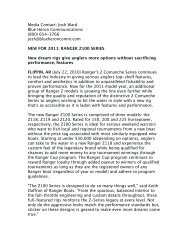Bass Boats - Ranger Boats
Bass Boats - Ranger Boats
Bass Boats - Ranger Boats
You also want an ePaper? Increase the reach of your titles
YUMPU automatically turns print PDFs into web optimized ePapers that Google loves.
nice response to the trim resulting in a high<br />
bow angle at wide-open throttle. The 188VS’<br />
bow attack angle and nimbleness across the<br />
water make you feel like you are going a lot<br />
faster than the GPS indicates.<br />
Of course, those very same attributes lead<br />
to a boat that takes a little driver skill and concentration<br />
once the 188VS pops up on the pad<br />
and you trim it to eek out those last couple<br />
mph — or encounter boat wakes where it<br />
pays to get the bow down.<br />
■ Rod and dry storage are bountiful aboard the <strong>Ranger</strong> 188VS. Note the built-in rod organizer in the<br />
port rod locker.<br />
Seeing them fishing and motoring around<br />
the lake in a boat that you’d swear would sink<br />
at any second reinforced one of the points<br />
common to all <strong>Ranger</strong> boats: They are built<br />
well beyond industry standards and Coast<br />
Guard requirements. That’s both good and<br />
bad, depending on your perspective.<br />
The good part is that <strong>Ranger</strong>’s boats are built<br />
stout using the very best materials, from the<br />
thick-walled storage compartments and highgrade<br />
carpet to the resins, materials and the<br />
bonding adhesives used to build the boat itself.<br />
That makes for a boat that is going to hold up to<br />
the most severe use for years while providing a<br />
solid, safe and well-designed fishing platform.<br />
On the downside, because <strong>Ranger</strong>s are built<br />
stout, they weigh more than many of their competitors’<br />
boats, which oftentimes makes Flippin’s<br />
finest a tad slower when it comes to<br />
speed numbers.<br />
Those who buy <strong>Ranger</strong>s already know all<br />
that and would prefer owning a boat that has<br />
earned a strong reputation within the industry<br />
for fit, finish and fishability. The <strong>Ranger</strong><br />
188VS dual-console looks like it’s going to continue<br />
that reputation.<br />
place) directly to the hull, fill the voids with<br />
floatation foam, and the result is basically a<br />
one-piece boat.<br />
The 188VS’ solid hull negates the sound of<br />
water slap and vibration, which, in turn, gives<br />
you a very real sense that you are running in a<br />
much bigger, heavier boat.<br />
But it handles more like a sports car. The<br />
wide 921/2-inch beam, coupled with Sea Star<br />
Pro hydraulic steering, and the short hull make<br />
it easy to slip in and out of tight areas or to maneuver<br />
in the crowded waters around the boat<br />
ramp at day’s end. This boat would feel right at<br />
home on small impoundments, reservoirs, lakes<br />
or on any river short of the lower Mississippi.<br />
Out on the open water, those familiar with<br />
older <strong>Ranger</strong>s will find the 188VS very similar<br />
in handling to the old 350V, which exhibited a<br />
A TRUE PERFORMER<br />
Speaking of wringing out the new <strong>Ranger</strong>, we<br />
couldn’t resist doing that repeatedly because,<br />
well, it was just plain fun.<br />
Our test boat was rigged with an Evinrude<br />
E-Tec 150 propped with a 22-inch-pitch Raker.<br />
The 188VS is rated for up to 175 hp, which I’d<br />
recommend for those with a need for speed<br />
— or at least the need to see 60 mph.<br />
The 150 ’Rude responds quickly and smoothly<br />
to throttle demands, and with the little Raker<br />
on the business end, it popped the <strong>Ranger</strong> to<br />
30 mph in 8 seconds. That’s a fairly quick<br />
holeshot for a boat that weighs somewhere in<br />
the neighborhood of 2600 pounds with two<br />
bubbas aboard.<br />
Fuel economy is just as impressive. Evinrude<br />
is big on promoting the fuel-efficiency of<br />
the E-Tec technology. During our tests, the 150<br />
E-Tec averaged 3.4 mpg from the time it rolled<br />
on plane until it reached top end. The best fuel<br />
number we saw was 4 mpg at 3000 rpm (29.9<br />
mph), which gives the 188VS a cruising range<br />
of nearly 140 miles on its 38-gallon fuel tank.<br />
The performance disappointment came at<br />
the top end; we could only get the 150 E-Tec<br />
to turn 5200 rpm, which resulted in a top<br />
speed of 54.8 mph. We were expecting a top<br />
speed in the high 50s.<br />
ONE TOUGH HULL<br />
<strong>Ranger</strong> builds its bass boats with the notion<br />
that the less flex between hull and deck cap<br />
the better. To that end, they use a process<br />
called “pulltrusion” to make the fiberglass<br />
composite material used in the floor, transom<br />
and deck. The pulltrusion composite is closer<br />
in strength to steel than fiberglass. Plus, they<br />
put stress-directed fiberglass in the strakes<br />
instead of putty and use one-piece fiberglass<br />
stringers to further stiffen the hull.<br />
Add in structural bonding agents that cement<br />
the deck cap (which is molded with the<br />
storage boxes and other compartments in<br />
38 April 2006 <strong>Bass</strong>AndWalleye<strong>Boats</strong>.com<br />
■ The driver console is nicely laid out, including placement of the Lowrance X-135 depthfinder and<br />
the array of toggle switches that control boat power. Legroom at the helm is enough to keep over-sixfooters<br />
in the comfort zone.








